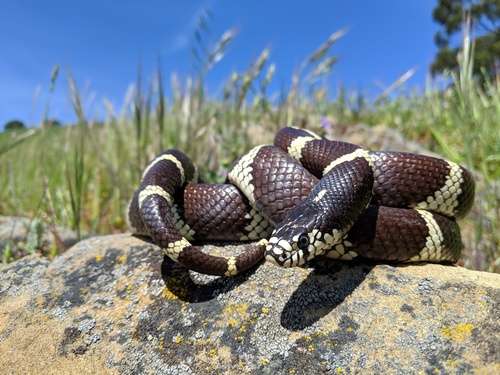
Description:
Scientific name: Lampropeltis getula californiae
Life span: 20 years
The general pattern of alternating dark and light bands can be any hue, from black and white to brown and tan or yellow, despite its extreme variability in appearance. The scales are glossy, unkeeled, and smooth (without a raised central ridge).

Native Region/Habitat
The southwestern United States, from California eastward to Arizona, is home to the California Kingsnake (L. californiae). They are widespread in a range of environments, and neighborhood kids frequently catch them to keep as pets.
Behavior:
When compared to snakes of a similar size, California kingsnakes are quite calm, but they can be fearful. They usually won’t turn hostile until they are disturbed. Hissing, curling into a ball, and rapidly vibrating the tail are indications that your California King is under stress (like a rattlesnake).
Care As a pet/In captivity:
- Any “normal” snake cage can be used; for an adult, a fifteen to twenty gallon tank will do. Hatchlings do best in small “Critter Keeper” cages or plastic shoe boxes because they are sensitive to dehydration.
- The majority of California Kingsnakes are fed mice all of their lives. Hatchlings should be fed every five to seven days and typically feed easily on newborn “pinkie” mice. When the snake becomes bigger, make the meal bigger. Every 10 to fourteen days, one or two adult mice are enough to support even the largest adult. Hatchlings frequently experience “lost” or insecure feelings when kept in a big cage. If placed overnight in a tiny deli cup with a pinkie and a folded paper towel to hide beneath, these animals will frequently feed happily.
- By putting a heat pad beneath one end of the cage, create a thermal gradient. The snake should be able to select between warmer temperatures (about 90-95F) at the warm end and colder temperatures (around 78-83F) at the cooler end thanks to this. To ensure that the snake feels secure in any climate, provide sufficient hiding places in both warm and chilly areas. Avoid temperatures below 75 degrees Fahrenheit. These nocturnal animals don’t require any additional lights.
- Give a small dish with clean water. Low humidity is recommended to prevent respiratory issues. Certain snakes, especially the tail tip, may have shedding issues because of the variety of cages and living conditions. Provide a small plastic container with lid and damp sphagnum moss inside if this is discovered (cut an access hole in the side).
Table





